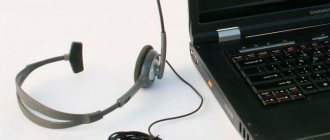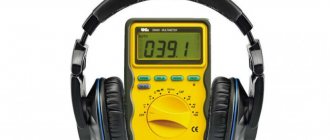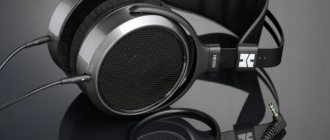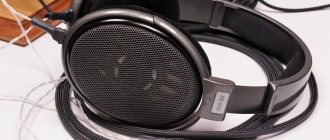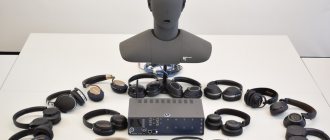The reinforcement emitter in the original is called “balanced armature” and does not have an exact translation. The following names for headphones with this emitter are usually used:
- Armature headphones
- Balanced Armature Headphones
- Headphones with balanced armature
- Balanced fittings
And many other phrases with the words “reinforcement”, “anchor”, “balanced/balanced”. The design of the operation of the reinforcement radiator is so far from dynamic and so little variation among reinforcement radiators that any name is suitable.
The reinforcement emitter looks like a rectangular oblong bottle, where the sound is emitted from the neck. Thus, the radiation axis coincides with the main length, and the width and height of the emitter are relatively small. Thanks to this shape, this type of emitter has become widespread in in-ear hearing aids, where a conventional dynamic emitter cannot be placed in a narrow ear canal.
Marketers from different companies like to compare the dimensions of an armature and dynamic driver, showing that the armature driver is much smaller and plays no worse.
But the laws of physics cannot be fooled, and all the parameters that depend on the dimensions are also valid for an armature driver: small dimensions limit the bass and overload capacity of the driver.
In order for armature headphones to be as good as dynamic headphones in terms of overload capacity in the low-frequency region, it is necessary either to use an armature emitter with comparable dimensions or to use several emitters simultaneously.
Like any driver, armature or dynamic, the type itself is not synonymous with defining quality or mandatory characteristics. There are budget models with mediocre sound, and there are expensive and very expensive ones with high sound quality. It is completely pointless to compare inexpensive armature headphones with expensive dynamic ones and vice versa. Preferences will often be towards an expensive model, regardless of the type of emitter.
Structurally, with the same membrane area for the reinforcement and dynamic emitter, the membrane stroke is greater for the dynamic one. For this reason, dynamic drivers have a higher overload capacity, which is expressed in the absence of crackling sound at high volumes. When the task is to obtain the same bass as a dynamic radiator using a reinforced one, a large total area from the reinforced radiator is required (compensating for the small stroke of the membrane).
An additional disadvantage of many armature drivers is their narrow neck, which adds distortion in the low-frequency region due to the inability to “pump” the required volume of air. The neck is necessary for attaching the sound guide to hearing aids. Probably for this reason, the reinforcement emitters of the SONY company (which does not produce its emitters for hearing aids) do not have a neck.
Development of armature headphones
In the history of the origins of armature headphones, Jerry Harvey played the most prominent role.
At that time, reinforcement emitters were used primarily in hearing aids. If the hearing impaired were only interested in the mid-frequency range (to hear the speech of others) and high volume, then musicians and audiophiles needed a wide frequency range, high overload capacity and the highest possible sound quality. This required a completely different approach.
In 1995, Jerry Harvey created the first custom monitors for musicians, laying the foundation for the development of multi-driver models. Custom monitors were an analogue of a hearing aid with high noise insulation for performing on stage. The case of custom headphones (as well as hearing aids) is made individually according to an ear impression, which ensures a secure fit and the best noise insulation. For musicians, custom monitors are called personal ear monitoring systems.
The use of several emitters made it possible to obtain high sound quality and move away from the level of “hearing aids”. Gradually, successful custom models migrated to universal headphones and are widely used today.
A little earlier, in 1991, Etymoic introduced the ER-4 model (still in high demand among single-driver models). However, the single-driver ER-4 is primarily intended for audiophiles.
Among audiophiles there are many adherents of both single-driver models (no filters and, accordingly, less phase distortion) and multi-driver models (more phase distortion due to filters, but with an advantage in some other parameter: overload capacity, deep raised bass, etc. .P.).
Top best models with reinforcement + dynamic technology
Xiaomi Mi In-Ear Headphones Pro 2
A good budget model that is suitable for those who want to get good sound for little money. The weight of the product is 14 grams, but you can hardly feel it at all. Cable type – symmetrical. The reproduced frequency range is 20-20000 Hz, while the impedance is 32 Ohms. Maximum power – 5 mW. Of course, this is not the highest figure compared to flagship models, but it’s also not bad. Sensitivity – 100 dB. Cable length – 1.25 meters. The connector shape is L-shaped.
Sold at a price: from 1,500 rubles.
Xiaomi Mi In-Ear Headphones Pro 2
Advantages:
- Good deep bass;
- Sound 9.5 points, considering the price;
- They fit tightly to the ear, which allows you to even run with headphones;
- High-quality connector that does not deteriorate from frequent use;
- Assembly is on point.
Flaws:
- There are no significant ones.
SIMGOT EM2
A more expensive model that will appeal to all connoisseurs of high-quality sound. Good technology provides better sound. Sold in several colors, allowing you to purchase more suitable shades. No fastening is provided. There are two drivers and a detachable cable. The first affects playback quality, and the second affects ergonomics.
The shape of the connector is straight, which for some may seem like a serious drawback, but there is no need to rush to conclusions. Because, despite this design, the product will last longer than any other option.
The average cost is 7,500 rubles.
SIMGOT EM2 headphones
Advantages:
- Clear and detailed sound;
- There is a slight bias towards low frequencies;
- High quality wire;
- Long service life;
- Efficiency;
- Reliability for several years;
- Convenient detachable cable;
- Possibility of creating a wireless connection using a proprietary adapter.
Flaws:
- External sound penetrates a little.
Fiio FH5
A popular company that produces some of the best headphones and is suitable for daily listening. The product is made of durable material that does not wear out even after one year. Sold only in two colors: gray and black.
There are 4 drivers, of course, all naturalness disappears, but for some this is not as important as clear sound with good detail of the instrumental. Sensitivity – 112 dB per mW. The range of reproduced frequencies is 15-40000 Hz. For greater convenience, there is a detachable cable, so in case of any problems, it can be quickly replaced.
The average cost is 21,690 rubles.
Fiio FH5 headphones
Advantages:
- Excellent fit to the ears;
- Comfortable even when running;
- Reliable performance;
- The sound is high quality, good performance when listening to growling, rapcore and metalcore;
- Assembly 5 points;
- Behind-the-ear fit.
Flaws:
- Not found.
Soundcore Liberty 2 Pro
Reliable wireless headphones that are comfortable and sound. There is an LED indicator and 4 microphones. The product belongs to the True wireless category. The connection is provided via Bluetooth version 5, which is a separate advantage. Handsfree, A2DP, Headset, etc. are supported. The battery life is 8 hours, which is the optimal solution. The kit includes a convenient case that recharges the headphones after use. The Quick Charge function allows you to charge the product in 10 minutes, and it will last for 2 hours.
The average cost is 9,400 rubles.
Soundcore Liberty 2 Pro headphones
Advantages:
- Build quality is at a high level;
- Long service life;
- Efficiency;
- Reliable performance;
- The sound is clear;
- Capacious battery;
- Fast charging;
- Supports various options.
Flaws:
- Not found.
MEE audio M7 Pro
A convenient option that features high-quality assembly and an attractive design. Impedance – 16 Ohms. Sensitivity – 96 dB per mW. There are two drivers, which is an advantage for some users. The cable is easily disconnected. The range of reproduced frequencies is 10-2000 Hz. The design is comfortable and fits snugly to the ear without causing any discomfort. Extraneous sounds are well muffled, so nothing will interfere with listening to your favorite song.
Sold at a price: from 12,500 rubles.
MEE audio M7 Pro headphones
Advantages:
- Attractive performance:
- High-quality assembly, nothing creaks or breaks;
- Minimal wear during active use;
- Good sound for a long period;
- Value for money.
Flaws:
- Not found.
Many drivers and sound quality
Lately, manufacturers have been trying to fit as many reinforcement emitters into an earphone as possible, hinting that the more emitters, the higher the quality. Today, among mass products, the number of drivers reaches 6 pcs. In non-mass and Custom headphones, the number of drivers can reach 12 or more (for example, JH Audio Layla).
Custom headphones with “only” 8 emitters
A large number of emitters does not always improve quality and creates problems with the dimensions of the final headphones, which limits the mass production of headphones with more than 3 emitters. In most cases, with comparable dimensions to a three-driver model, a 6-driver model simply uses smaller armature drivers. For example, the Westone W60 uses 6 emitters, but there are three bands for playback, and two identical emitters are used for each band. The cost with this approach increases not at all in proportion to the quality.
When it comes to Custom models, the ear impression often determines the maximum number of emitters that can be used and which headphone models are automatically excluded.
What is the real use of models with a huge number of drivers?
In concert monitors, due to the large number of emitters, they try to increase the sensitivity of the headphones, which in turn provides loud sound even from weak sources (you never know what kind of equipment you will have to work with on stage).
Usually, if an ordinary user takes concert monitors, he often begins to complain about the good audibility of background noise from the source (for example, a telephone). Most companies developing multi-driver models are focused on musicians, and for this reason you need to be picky when choosing multi-driver headphones - the result does not often coincide with expectations. Most concert monitors are designed to be used in noisy environments and will be perceived by the deaf in less noisy environments. In this case, the transition from traditional models with three emitters does not contribute to the transition to a new level of quality, but only empties your wallet.
For audiophiles, it is necessary to configure the emitters so that they operate in a lightweight mode with a low level of distortion at normal headphone sensitivity.
In addition to the quantity and quality of emitters, the sound is greatly influenced by filters (crossovers), which divide the sound stream into separate frequency ranges. Due to the inability to use inductors and large capacitors, crossover and selection of emitters is a very expensive part of the development and sometimes affects the final quality more than the quality of the emitters individually. Headphones with a large number of emitters and a low price (even if it seems adequate for the total price of components) can be significantly inferior to famous models with a seemingly simpler element base.
As for the choice between Custom and regular headphones with comparable components from the same manufacturer, a custom case usually costs between $200 and $500.
There is safety in numbers
It was the limitations in the width of the frequency range that led to the emergence of headphones with two or more emitters. Models are mass-produced that include two, three and even four “reinforcement” emitters. There are headphones that have a radiator with a balanced armature as a midrange/high-frequency element and a large low-frequency dynamic radiator. This option, of course, is not ideal in terms of sound quality, but it costs significantly less than two or more “fittings” in one housing. And conventional dynamic headphones are superior, at least technically.
Three-way armature headphones Fischer Audio TBA-04
There are also headphones with multi-band dynamic drivers. These are most often coaxial designs with mid/high-frequency and low-frequency speakers, less often models with an isobaric operating principle, when two identical drivers emit sound into one chamber, from which a sound guide goes into the ear canal. The first option provides cleaner sound with better resolution, while the second allows you to significantly increase power and get deep bass without increasing the detail of the sound.
Drawing analogies between multi-band headphones and multi-band acoustics, one cannot help but wonder how the frequency separation occurs in this case. Depending on the design and combination of drivers, multi-band headphones may actually use crossovers. We are talking about the simplest first-order filters, consisting of a single element.
HiFiMan HE-6 isodynamic headphones, planar driver
Among the large models intended for listening at home, you can find headphones with electrostatic and isodynamic (planar-magnetic) emitters. These are extremely expensive high-end models, and electrostatic headphones require special proprietary amplifiers, while isodynamic headphones require regular headphone amplifiers. Both technologies can hardly be called affordable, much less widespread.
Continuation: Guide to choosing headphones (part 3): read the characteristics
Part one: Guide to choosing headphones for a big city
Round reinforcement
A separate type of reinforcement emitters is round reinforcement, known to many by the name of the first successful Siren Armature series. The round shape follows the dynamic drivers and competes with them only due to the quality or character of the sound. The main advantage is higher sensitivity and the absence of a neck. Today, with round fittings you can find mainly high-end single-driver models (such as Grado GR8 and GR10). In most cases, headphones with round fittings demonstrate neutral and smooth sound with high detail. Interestingly, Grado GR10 is positioned higher than GR8, although the class of headphones is the same and the models differ in tonal balance, GR8 have a “darker” sound, and GR10 has a “lighter” sound.
If previously single-driver headphones with broadband armature drivers were de facto standard quality for many (Etymoic ER-4, Klipsh X10, etc.), then headphones with round armatures have quite confidently supplanted the leading positions.
Models with inferior radiators of round fittings have not taken root on the market (S-Jays, Fischer Audio SBA-1), because there was no obvious advantage over a traditional balanced armature or speaker. The application for the use of “Siren Armature” as a guarantor of quality did not cause delight among consumers, because there were inflated expectations among different groups. The headphones could not compete with the reinforced Etymoic ER-4 and Klipsh X10 in terms of detail, or with the dynamic models in terms of quality.
Perfect smooth sound. Review of Campfire Audio Satsuma armature headphones
It's no secret that the products of the American brand Campfire Audio cost a lot of money. This is true, but recently the company has released several affordable models. One of these new products was a single-driver model, created on the basis of a radiator with a balanced armature. Campfire Audio Satsuma cases are 3D printed and ABS plastic was used in production. For me, these headphones have become the standard for smooth sound in their price range. There is no emphasis on the upper mids, which is usual for the ch-fi segment, there is no wild blockage in the lower frequencies, lower mids. Americans value their reputation and continue to produce exceptionally high-quality products.
Characteristics of Campfire Audio Satsuma:
| Headphone type | in-channel, reinforcement |
| Number of emitters | one |
| Dynamic emitter | — |
| Armature emitter | one emitter |
| Housings | ABS plastic |
| Resistance | 46 Ohm |
| frequency range | 5 Hz – 18 kHz |
| Sensitivity | 94 dB/mW |
| Cable | removable, 1.2 m, 3.5 mm, MMCX |
| Jack | L-shaped, 3.5 mm, gold plated |
| Color | orange |
| Weight | 3 grams (one earphone) |
| Microphone | — |
The headphones are supplied in a small paper package. The square package consists of several parts. The thin cover was secured with a round sticker, and underneath it was a cute orange box. On the cover you can see a picture of the cases, as well as various quality certificates.
Equipment:
- 1. Campfire Satsuma.
- 2. MMCX braided wire.
- 3. Brush for cleaning ear pads.
- 4. Warranty card.
- 5. Instructions.
- 6. Case “Vine Green” from Portugal.
- 7. 3 bags for storing accessories.
- 8. Velcro cable tie (2 ties).
- 9. Three pairs of foam ear pads (small/medium/large).
- 10. Silicone Final Audio Tips (xs, s, m, l, xl).
- 11. Campfire Audio silicone tips (s, m, l).
I liked the complete light green case. There's not much space inside, but it's enough for wired headphones. The walls are of medium hardness, the cover more or less fulfills the protective functions. The inside walls are upholstered with artificial material. The quality is good, I did not find any protruding threads or unevenness.
There is a brush for cleaning ear pads, with a thin metal insert for removing earwax. There are enough attachments in the kit, there are foam ear pads without memory effect, plus three sets of silicone ear pads are included. If everything is clear with foam ones, then silicone ones surprised me. In one of the kits, a non-standard recess was made in the rod itself; it completely replicates the protrusion on the sound guide. I would like to note that Campfire Satsuma headphones react to replacing the ear pads; the sound character changes dramatically. I don’t know what all this is connected with, perhaps with a neutral presentation, but the sound changes in a very specific way. All the attachments were placed in small bags, which in turn tighten and cover a small hole (the contents cannot simply be shaken out).
The cases are made of ABS plastic and stainless steel. The design is very simple, yet quite reliable. On the lid we can only see the manufacturer's logo. The cases are miniature and light, they get lost even in small ears and do not fall out. There are no complaints about the shape; these headphones fit my ears just perfectly, as if I had ordered a custom version for myself.
The sound guides are of medium length, with a proprietary rim for fixing the attachments. As I already said, some attachments repeat this ring in the rod, due to this we will get improved fixation. The quality of the headphones is 10 out of 10, I did not find any burrs, gaps, or irregularities. The sound guide is made of stainless steel.
The developers decided to do without the usual removable mesh. I don’t even know if the protective insert can be removed; most likely it is not removable. I did not find any compensation holes on the plastic.
The MMCX connector is used to connect the wire. This connector does not protrude from the base of the case. The wire is inserted until a certain click is heard and then scrolled with some force. I also liked how the headphones look when assembled; the insert part is quite miniature. Sound and sound insulation depend 70-80 percent on the nozzles, passive sound insulation is very good, you just have to choose the right nozzles. The Americans did not ignore fans of bass sound by releasing the “Honeydew” model. This is a single-driver model in the same body, but with a powerful and bass sound.
It’s worth talking separately about TAEC technology. The company’s engineers are making a special acoustic chamber using three-dimensional printing. This solution allows for less distortion in the high-frequency range. This technology is used in some other models of the company. One broadband reinforcement emitter is installed; this emitter is responsible for processing the entire frequency range (from 5 hertz to 18 kilohertz).
A light and inconspicuous wire was selected for the light cases. The disadvantages include a slight memory effect. The cord is woven from four strands; due to its small diameter, it still often gets tangled. This same wire is included with some other headphones, such as the Andromeda and Polaris. What else can you say about it... There’s not much to add, it’s a high-quality and convenient cable, it doesn’t have a microphone effect, and doesn’t interfere with enjoying music.
There is a metal splitter with a lock for the point of divergence of the wires. MMCX earhooks with color-coded channels. The left and right channels are indicated by a small dot, as well as an additional LR marking. The plug is L-shaped, with a protective terminal.
Sound.
Measurement equipment: Vibro Veritas. Headphones for comparison: iBasso IT00, Ikko OH10, FiiO FH5, Shanling ME200, Periodic BE, Periodic Carbon, Meze 99 Neo, TFZ Tequila 1, Moondrop Aria 2021, TFZ Live 3, FiiO FA9 and many others. Sources: Daart Canary, EarMen Eagle DAC, Shanling M5S, Daart Aquila 2 DAC. Cable: complete.
The presentation is neutral, with minimal emphasis on the high frequencies to highlight the strengths of the armature driver. Warming up is useless in this particular case. The source plays a certain role, for these headphones I tried to choose a DAC with a slightly colored feed, getting a dense and solid sound. For the first time, you can purchase an inexpensive DC series whistle from iBasso, but in the future I would advise purchasing a cooler sound source. We were not deceived by the characteristics; the highs do not break off after five or ten kilohertz. Some waviness is noticeable at high frequencies, since the measuring equipment can give a slight error, and most often this happens precisely at high frequencies. I didn’t notice any joints; we get a very solid and homogeneous sound, with good frequency control. The strengths of this model are excellent frequency balance, decent detail and incredibly fast and clear bass.
High frequencies.
In normal quantities, there are not so many of them. As often happens, harshness and causticity appear in low-quality recordings. With high-quality tracks we will get excellent control. The length is decent, the effects and cymbals are played out in full, and the elaboration of the smallest nuances and attenuations is pleasing. The hybrid “LZ A2 Pro” and “FiiO FH5” more noticeably emphasize this part of the range due to a larger number of emitters. Models from LZ and FiiO have a V-shaped frequency response and in comparison this is very noticeable. I didn’t bother with overlaying the frequency response graphs, everything was so obvious.
Low frequencies.
Record fast and collected bass with good punch. The low frequencies are linear and correct, they do not interfere with neighboring frequencies, allowing you to enjoy live low-frequency instruments and vocals. The separation of instruments is simply incredible. In many tracks you pay attention to the keyboards, bass guitar and double bass - you can hear the smallest details and ideas of the musicians. Deep sub-bass is presented in small quantities, but it is enough for electronic genres. And yet the headphones will ideally reveal classical and instrumental, folk music, jazz, and blues. For pop and electronic styles I would go with Campfire Honeydew.
Mid frequencies.
The middle turned out to be open and monitor-like. The lower half of the midrange came out very dense and realistic. The virtual stage is wide, almost beyond the head. The construction of virtual space is impressive; as it turns out, with such tuning you can squeeze out surround spatial sound. The headphones show everything as it really is, they do not try to embellish or inflate the musical instrument. Small nuances and events in the background can be heard well.
Wired headphones Campfire Audio Satsuma in the online store doctorhead.ru
Opinion.
I'll say it briefly - excellent headphones with neutral sound, excellent build and rich equipment. The cases, of course, look a little strange, as if they were toy, unreal, but you gradually get used to this design and don’t worry. I consider my acquaintance with the cheapest headphones in the Campfire Audio line to be successful; my impressions are purely positive. The model is very interesting and definitely deserves the attention of buyers.
Advantages and disadvantages of an armature emitter
Advantages
- Most emitters do not require a separate chamber (equivalent volume). This allows the headphone body to be used in any shape.
- Single-driver armature headphones have a rise in impedance in the high frequency region, which allows you to reduce the level of distortion of the headphone amplifier and get better sound (for example, in the Grado GR8 and GR10).
Flaws
- With equal dimensions of the reinforcement and dynamic radiators, at best there is parity, at worst, the loss of the reinforcement radiator in the low frequency region. An armature radiator can gain an advantage only in a multi-driver system, where a separate driver will be responsible for individual frequency ranges (for example, a small-sized, lightweight one for high frequencies, the largest and heaviest for low frequencies, as in Shure SE425, Ultimate Ears TripleFi 10).
- Low frequencies are the most difficult for armature drivers (low stroke and throat) and, following conventional multi-driver armature headphones, hybrid systems began to appear, where the speaker is responsible for the low-frequency range, and the armature is responsible for the mid and high frequencies (for example, Sony XBA-Z5, AKG K3003, T-PEOS H-100).
The hybrid system requires a separate chamber for the speaker and therefore the ergonomics replicate traditional dynamic models.
Peculiarities
- If for dynamic headphones the resistance value indirectly affects sensitivity to voltage and high-impedance headphones belong to the class of “quiet and unsuitable for portable devices,” then reinforcement headphones do not have such a connection. The resistance can reach up to hundreds of ohms and compete in volume with dynamic headphones with a resistance of 16 ohms.
- For multi-driver armature headphones, the impedance line may have a high spread of peaks and valleys and, accordingly, require a high-quality amplifier to unlock the potential of the headphones. Depending on the nature of the impedances of the headphones and amplifier, the final frequency response of the headphones will change.
Sound
How headphone fittings affect sound
Most of the headphones we've heard are dynamic - they are designed in the same way as speakers with a speaker, but smaller in size. The speakers can produce a wide frequency range, but are susceptible to distortion. Therefore, for example, musicians on stage use armature devices as monitor headphones, which are more reliable.
The reinforcement emitters are based on a movable U-shaped ferromagnetic armature, which acts on the membrane. The influence of the membrane here is minimal: the sound is more accurate and nuanced than that of dynamic drivers. The main disadvantage is the meager frequency range of such emitters. FiiO effectively combats this disadvantage: for example, the FA1 uses a wideband emitter, and the FH5 helps with bass with an additional speaker.
In FA7, they made do with only “armatures” operating in different ranges. Each earphone has four Knowles emitters built into it: CI-22955 for low frequencies, ED-29689 for mids, and two SWFK-31736 per ear for highs. The built-in crossover is responsible for matching the drivers - the output should be a balanced sound with a wide frequency potential (the declared frequency response is 20–40,000 Hz).
What does the Hi‑Res Audio certificate provide?
FA7 conforms to the high-resolution audio standard Hi‑Res Audio. This means that the headphones support audio files with bit depths and sampling rates higher than the generally accepted 16-bit and 44,100 Hz and can also reproduce frequencies above 20,000 Hz. This is in theory.
In fact, even tracks in lossless formats can have a sample rate of 44,100 Hz, and this will be enough. And also, a person does not need audio with frequencies above 20,000 Hz. Above this threshold there is ultrasound, which we cannot hear. Therefore, the Hi‑Res Audio mark is, rather, just a notification that we have serious headphones that need an appropriate source and music with a high bitrate.
We used the FiiO FA7 with a MacBook Pro without external DACs or amplifiers, as well as with the FiiO M7 Hi-Res Audio player. Accordingly, music: in the first case, these are tracks from streaming services, in the second - FLAC audio.
Sound character
The first thing that catches your eye is the bass. They absolutely do exist. Let us remind you: it is this part of the range that is usually considered problematic for armature headphones. At the same time, the advantages of the “reinforcement” remained in place: the sound is detailed and nuanced. Some tracks really sound new - it’s hard to say for better or worse, but definitely different. Typically, these changes relate to the vocal portion of the range, the priority and placement of the voice in the mix.
When fitted correctly and with ear pads of the appropriate size, the FA7 have complete noise isolation, and even when the music is paused, some sounds from outside will not penetrate inside. In the city this can be dangerous - when crossing the road, it is better to take out your headphones.
The volume potential here is more than sufficient and depends on the source. When listening to music from the player, I stopped at 50% of the available volume. When it increases to 80–100%, it becomes uncomfortable. At the same time, I did not notice any distortions or unpleasant jumping frequencies.
FA7 have a musical and not completely objective sound. There are super-massive, sometimes even too noticeable bass, detailed mids and smooth, unproblematic “tops”. There are no complaints about the sound - it seems that there is even too much bass here only in those moments where it is appropriate.
The FA7s retain their distinctive sound style when listening to music from any source, but they definitely highlight the difference between a regular consumer player and a Hi-Fi player. It is not advisable to use this model with just anything.
We ran several different tracks with headphones to evaluate the different nuances of the sound.
Scene development: Pink Floyd - Money. Samples of the sounds of cash registers and the clinking of coins in the intro of this track act as a separate instrument - they are divided into channels and seem to be scattered across different locations. Experiments with panning continue throughout the track - almost all the instruments here sound a little to the left, then a little to the right, now closer, now further away.
FiiO FA7 reveals all the tricks conceived by Pink Floyd with a panorama - you can close your eyes and imagine what played and where it came from.
Bass: Tyler, The Creator - Earfquake. Perhaps not Tyler’s most “bass-heavy” track (you can at least remember Who Dat Boy from the previous album Flower Boy), but still with an abundance of both “low-end” and higher frequencies. Because the bass only enters at 24 seconds, you can see how the mix changes with its introduction.
Lots of bass. It doesn’t overlap other frequencies, but it sounds somewhat separate from the mix—perhaps these are mixing nuances. And this is the moment when I would like to make the bass a little quieter, but, as experience shows, many fans of the most “bassy” genres, hip-hop and trap, do not like to make the bass a little quieter.
Simultaneous high and low frequencies: Vince Guaraldi Trio - O Tannenbaum. The jazz composition from A Charlie Brown Christmas features only three instruments: a drum kit, a double bass and a piano, often playing in the upper registers.
Despite the abundance of low frequencies of the double bass, there is no problem here as in the previous track - there is just the right amount of bass here. High frequencies are not annoying even at high volumes. Everything is fine.
Sound balance in difficult scenarios: The Mars Volta - Cicatriz ESP. A 12-minute track with dozens of instrumental tracks and moments that are completely different in sound: sometimes melodic and minimalistic, sometimes busy and dissonant.
The headphones coped with this and other The Mars Volta compositions - during the test, I accidentally listened to the band's first album in its entirety. And here the nuance that I noted earlier showed itself - the vocals sounded a little differently: at times it became a little more distant. Perhaps these are mixing features that could be smoothed out when listening with regular dynamic headphones.
Emitter quality and type
Armature headphones are often considered to be of higher quality, but it is important not to fall for some manipulations.
Smooth frequency response
Due to the low overload capacity, most armature headphones do not have a rise in the low frequency region, which ensures a flat frequency response (technically correct). In certain cases, this can be qualified as higher quality - a more correct tonal balance and often “fast and articulate” bass. However, there is a psychoacoustic adaptation to the tonal sound at the ear, similar to the adjustment of vision to white balance. In addition, on the street and in transport, the rise in the low frequencies compensates for the surrounding low-frequency hum and therefore dynamic headphones for the street are in high demand. A smooth frequency response exists not only with reinforcement headphones; among dynamic headphones there are exceptions to the rules in the form of “non-bass” models, like Hifiman ReZero, Re 100/400.
But all other things being equal, if you need to choose headphones with a “flat” frequency response, armature single-driver headphones are preferable, because It’s easier for the amplifier to work the mid- and high-frequency ranges of reinforced headphones and, accordingly, get less distortion at the output.
The most expensive headphones are armature ones, which means they are the best
Among the most expensive headphone models you can see mainly armature models. The high cost is dictated by the quantity, quality (cost) of emitters and filter settings.
In most cases, multi-driver dynamic models cannot be made due to the geometry of the dynamic drivers and the housing requirements. This ensures primacy among the most expensive headphones for armature models. But the concept of “best” applies only within its price range, and not to all models.
Conclusion
The reinforcement radiator is a full-fledged alternative to the dynamic radiator. Due to the design features, the housing of headphones with reinforced emitters can be of any shape and allows the use of a multi-driver system. The sound quality depends on the specific model, however, due to the fact that the roots of the development of reinforcement headphones go back to the professional sphere, in most cases, reinforcement headphones have a more natural sound. Dynamic headphones (within their price group) are leaders in bass depth and high overload capacity, which is why they are in high demand for outdoor use. Seasoned audiophiles very often keep different types of headphones in their collection or periodically change them. What headphones do you use?
Author Kuznetsov Roman romanrex
Headphone emitters. Armatures, speakers, hybrids. Basic myths
Audiophiles rarely express themselves in understandable language. It's a pity. The topic of choosing headphones is relevant for a huge number of people, including those who have not yet managed to become enlightened to the level of orthodox aesthetes. Even when buying wireless models, friends often ask me how armature headphones differ from dynamic ones and which is better.
I will try not to go into details and talk more about the practical side of the issue.
Types of emitters. Technologies and features
I don’t know if it will be interesting for you to read here about the operating parameters of different drivers. But still, let’s go over them in a nutshell. So:
— The speaker consists of a membrane and a coil attached to it. Its movement is carried out due to the interaction of the magnetic field and electrical impulses. Depending on the specific size and material of the membrane, the sound frequency will be processed more or less accurately.
— The armature is a tiny U-shaped anchor around which a coil is placed. Its very name comes from the English word “anchor” - armature - and not from what you think. The emitter is located in the center of a magnetic field through which an electrical signal passes and acts on the membrane.
— Electrostatic, isodynamic and orthodynamic headphones use completely devilish technologies. In electrostats, an ultra-thin membrane is located between two electrodes. Planars use a special magnetic grid, and a special pattern is applied to the surface of the film membrane for the desired direction of current. The difference between isodynamic and orthodynamic models lies in the characteristic shape of the permanent magnets.
And a little more theory:
Single-drivers are, obviously, headphones with a single emitter.
Multidrivers are models that combine several emitters.
Hybrids are headphones that have different types of drivers installed. Previously, we mostly got a combination of armature and speaker, but now manufacturers are successfully experimenting with adding other types.
How to choose headphones by emitter. Sweet lie
Now, finally, let's move on to common myths and legends.
The first and most common mistake is to idealize a certain category of drivers. Brands diligently support this idea, praising one or another of their models, and at the same time unobtrusively transferring its advantages to the supposedly characteristic features of other headphones of this type. This is a convenient mechanism that gives you a chance that when, say, the next miracle speaker comes out, you will first buy the new product, and only then think about whether it really sounds like what you expect from it.
The second mistake is exaggerating shortcomings. The audiophiles themselves did their best here. It's hard to put yourself in another person's shoes and admit that they might like a sound that irritates you terribly. That is why there are many harsh statements in reviews about the dryness of the fittings and the sluggishness of the speakers. And after reading this, you will hardly want to buy any headphones with a similar driver, even if they are very impressive.
I do not deny that emitters may have a certain common signature. After all, they have a similar design. But the influence of this signature on the final sound picture is so minimal that even an experienced audiophile in a blind test will not be able to distinguish even a speaker from a fixture, much less ten-driver reinforcement monitors from five-driver low-impedance hybrids.
Of real importance are the methods of manufacturing the emitters, their sizes and materials, production control, adequate sound tuning, and consistency in the reproduction of different frequency spectra. Headphones made casually by the left hoof in a Chinese garage will not be helped by either hybridity or a wide frequency range. But at the same time, if a company produces high-quality models, even one driver can play just great.
Characteristic sound signature
I can't recommend you anything specific for your favorite genre of music. If only because everyone will have their own source, with which their ears will either sing or not at all. So, if you, for example, are a connoisseur of high frequencies, you do not have to strictly buy only the fittings; it is more important to select the appropriate sound for the combination as a whole.
But still, let's remember the main features characteristic of different types of drivers:
Speakers tend to sound bigger, more emotional and livelier than armatures. Even in a small space they can give scale and warm movement to a melody. The famous dynamic bass, beautiful and three-dimensional, manages to sound as natural as possible.
Emitters with a balanced armature are drier, more accurate and faster. More expensive, but better quality? Usually yes. But in order to get a rich and three-dimensional picture with them, it is better to choose multi-drivers. Single-driver armature headphones, in my experience, generally revealed the mids perfectly, but at the edges of the range they sounded noticeably worse, especially with insufficient amplification.
Planars and electrostats are recognizably good at micro-detailing, building a wide stage, and conveying natural timbres at high frequencies. They have a peculiar, but almost exemplary correct presentation. The disadvantage is the need for a lot of power to swing. In addition, such headphones are usually expensive.
Hybrids, ideally, should combine the best features of different emitters. If the manufacturer has worked to ensure that there are no unpleasant dips or rises at the driver joints, then this is what happens. And combining weighty live bass with detailed reinforcement mids and highs sometimes gives simply wonderful results.

